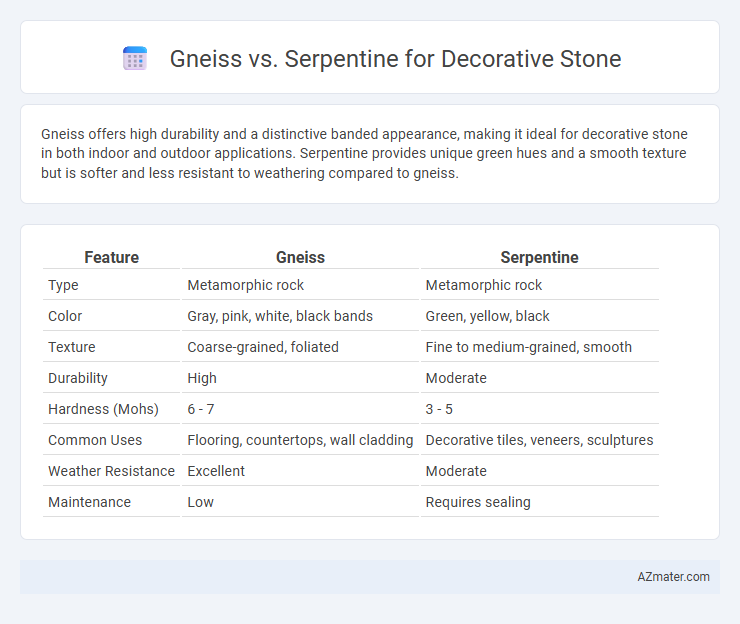Gneiss offers high durability and a distinctive banded appearance, making it ideal for decorative stone in both indoor and outdoor applications. Serpentine provides unique green hues and a smooth texture but is softer and less resistant to weathering compared to gneiss.
Table of Comparison
| Feature | Gneiss | Serpentine |
|---|---|---|
| Type | Metamorphic rock | Metamorphic rock |
| Color | Gray, pink, white, black bands | Green, yellow, black |
| Texture | Coarse-grained, foliated | Fine to medium-grained, smooth |
| Durability | High | Moderate |
| Hardness (Mohs) | 6 - 7 | 3 - 5 |
| Common Uses | Flooring, countertops, wall cladding | Decorative tiles, veneers, sculptures |
| Weather Resistance | Excellent | Moderate |
| Maintenance | Low | Requires sealing |
Introduction to Gneiss and Serpentine as Decorative Stones
Gneiss is a durable metamorphic rock characterized by its distinctive banded appearance and granular texture, making it a popular choice for decorative stone applications. Serpentine, a metamorphic rock known for its rich green hues and smooth, waxy surface, offers a unique aesthetic often used in interior design and architectural features. Both stones provide contrasting color palettes and textures that cater to various decorative styles and functional uses in construction and landscaping.
Geological Formation and Composition
Gneiss, a high-grade metamorphic rock formed under intense heat and pressure, is characterized by its distinct banded texture resulting from the segregation of quartz, feldspar, and mica minerals. In contrast, serpentine originates from the metamorphism of ultramafic rocks and is primarily composed of magnesium silicate minerals, giving it a smooth, often greenish appearance ideal for decorative stone. The varying geological formation processes and mineral compositions between gneiss and serpentine influence their durability, color patterns, and suitability for architectural applications.
Physical Appearance and Color Variations
Gneiss showcases distinct banding patterns with alternating light and dark mineral layers, creating a visually striking texture ideal for decorative stone applications. Serpentine exhibits a smoother, often waxy surface with color variations ranging from deep greens to yellowish and black tones, offering a rich palette for interior and exterior design. The contrasting linear patterns of gneiss and the more uniform, mottled appearance of serpentine provide diverse aesthetic options for architects and designers.
Durability and Weather Resistance
Gneiss offers exceptional durability due to its dense, coarse-grained structure, making it highly resistant to wear and mechanical weathering, ideal for outdoor decorative stone applications. Serpentine, while visually appealing with its unique greenish hues, is softer and more prone to chemical weathering and surface erosion, reducing its longevity in harsh environmental conditions. For long-term outdoor use, gneiss provides superior weather resistance compared to serpentine, ensuring sustained aesthetic and structural integrity.
Suitability for Indoor vs Outdoor Applications
Gneiss offers exceptional durability and weather resistance, making it highly suitable for both indoor and outdoor decorative stone applications, including countertops, flooring, and facades. Serpentine, while visually appealing with its rich green hues and smooth texture, is more prone to weathering and requires sealing, limiting its use primarily to indoor settings such as wall cladding and decorative accents. The mineral hardness and porosity differences between gneiss and serpentine directly influence their longevity and maintenance needs when exposed to environmental elements.
Workability and Ease of Fabrication
Gneiss offers superior workability and ease of fabrication due to its granular texture and consistent mineral composition, making it ideal for detailed carving and precise cuts in decorative stone applications. Serpentine, while visually appealing with its smooth, greenish hues, tends to be softer and more prone to chipping or fracturing during fabrication, requiring specialized tools and slower cutting speeds. The hardness of gneiss ranks higher on the Mohs scale (around 6-7) compared to serpentine's softer rating (around 2.5-5), enhancing its durability and suitability for intricate architectural elements.
Maintenance and Longevity
Gneiss offers superior durability and requires minimal maintenance, with high resistance to weathering and scratches, making it ideal for long-lasting decorative stone applications. Serpentine is softer and more porous, necessitating regular sealing and careful upkeep to prevent staining and surface damage. Gneiss's longevity outperforms serpentine, providing a more resilient and low-maintenance option for exterior and interior decorative use.
Environmental Impact and Sustainability
Gneiss, composed primarily of quartz, feldspar, and mica, offers durability and low porosity, making it a sustainable choice due to its long lifespan and minimal maintenance requirements. Serpentine, rich in magnesium silicate, involves more intensive quarrying processes that can disrupt local ecosystems and produce higher carbon emissions, impacting environmental sustainability. Comparing the two, gneiss typically has a lower environmental footprint, supporting eco-friendly construction practices while serpentine's distinctive green hues provide aesthetic value despite its higher ecological cost.
Cost Comparison and Availability
Gneiss is generally more affordable than serpentine due to its widespread abundance and ease of quarrying, making it a cost-effective choice for decorative stone projects. Serpentine, prized for its unique green hues and polished finish, tends to be more expensive because of its limited availability and complex extraction process. Both stones are available in various regions, but gneiss has broader accessibility, contributing to its lower price and quicker procurement times.
Choosing Between Gneiss and Serpentine for Decorative Projects
Gneiss offers a durable and heat-resistant surface with distinctive banded patterns ideal for high-traffic decorative projects requiring longevity. Serpentine provides a unique, vibrant green color and a smooth texture, making it suitable for accent pieces and low-wear installations. Selecting between gneiss and serpentine depends on balancing aesthetic preferences with the material's hardness, weather resistance, and maintenance needs.

Infographic: Gneiss vs Serpentine for Decorative Stone
 azmater.com
azmater.com